The Return of the Cheetah
From National Geographic News Watch:
Deep in the Karoo of South Africa’s Eastern Cape is a land starting over. The air is dry, the ground recovering from drought, and on high plateaus great plains of golden grass are home to large herds of zebra, red hartebeest, blesbuck and wildebeest. The animals never descend to the bushland below which is also home to its own herds of game and predators. When you’re high up on these beautiful plains, to gaze out on similar hills in the distance is like knowing a great secret of the hidden worlds atop each surface.
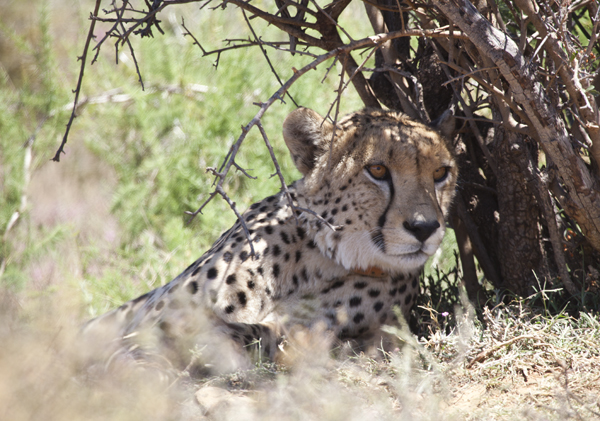
This male is in a soft-release enclosure. He has since been released into his new home on Samara.
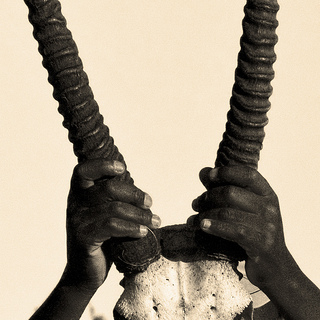
Samara Safari Guide holds up the skull of an oryx, an old kill by resident cheetah

A herd of blesbuck high on the hills of Samara
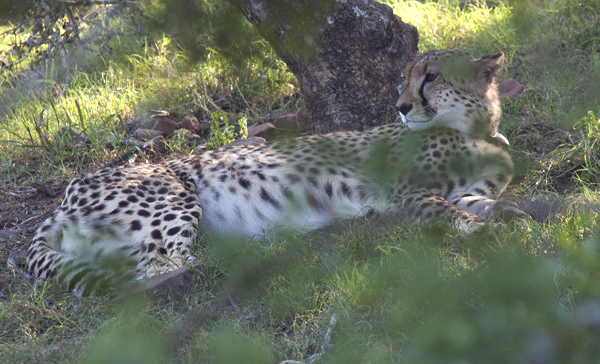
The Samara Private Game Reserve holds more than just this secret, it is home to a famous cheetah matriarch. Sibella was rescued from horrific torture that nearly took her life. In 2003, she was nearly ripped apart by hunting dogs and left in a cage to be shot until the farmer’s wife called the Ann van Dyk Cheetah Centre to take her. To date, she has contributed to 2% of the wild cheetah population of South Africa and is currently raising her 20th cub. Who could’ve guessed that a wild animal, brutalized by man, enduring painful surgery and recovery, could regain the strength to become a successful hunter and mother of many litters? Now in mid-2012, Sibella has had another litter of cubs on this land that hasn’t seen in a cheetah in nearly 125 years.
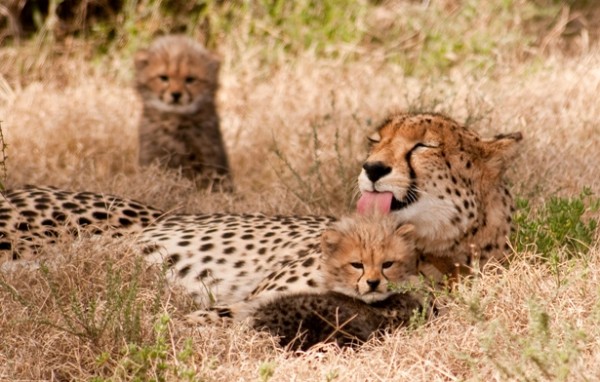
Sibella and her new cubs : photo courtesy of Samara Private Game Reserve, Marnus Ochse
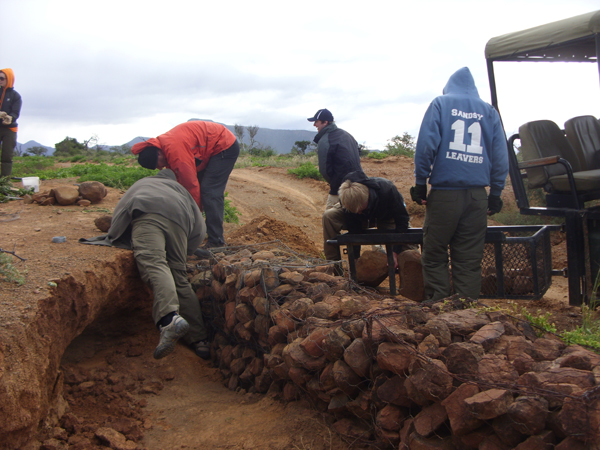
Volunteers implement erosion prevention techniques. Photo courtesy of Samara Wildlife Volunteer Programme, Edward Rice
Before the Samara Reserve was ready to take Sibella, the land was undergoing rehabilitation from generations of overuse by livestock farming. Sarah and Mark Tompkins purchased eleven farms, 70,000 acres, tore down the fences and let the land sit dormant for five years. They are still in the process of recovery as topsoil erosion and damage from overgrazing can be seen in some parts of the reserve. Gradually they reintroduced game to the land, taking care that the fragile ecosystem could handle the new population of animals. Even now the area is recovering from a long drought. Volunteers assist in erosion control techniques and the planting of spekboom which requires precious little water to survive. It is not just a simple solution of reintroducing animals to an area where they were driven out. If the land itself cannot sustain those animals, the efforts will fail. Samara was literally starting from the ground up.

Grassland on the plateau of the Karoo
I arrived during the holiday season, the tracker academy and volunteer crew were closed and gone for the month. Nevertheless, I toured the vast private reserve and saw something truly unique. I’d been asking about the cheetah and its place in Southern African mythology everywhere I visited in Botswana, Namibia and South Africa, receiving little more than a shrug as a response.

At the entryway to the cave is a painting of a cheetah, estimated to be 500 years old, by the Khosa people of the Eastern Cape
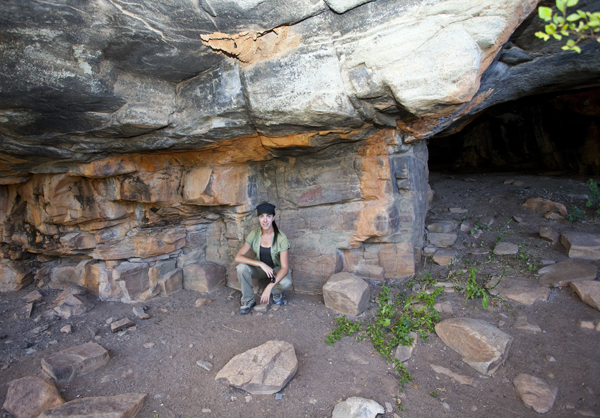
For scale, the author poses next to the cheetah painting just above and to the right of her shoulder
Humans have inhabited this region for over 20,000 years. Hidden in a remote corner of the reserve is a cave that overlooks the valley. The cave is a long drive from the main lodge. The easiest route is to reach the plateau, then scramble down to the entrance. Painted on the entrance wall is what appears to be cheetah. Evidence of its status in the Khosa culture, it is a vibrant image full of color and expression. Little is known about the settlement here and the paintings themselves, but the cheetah has a prominent place on the wall and great care was taken to illustrate the animal. It could have a full belly from a kill, pregnant, or be one of the cryptic ‘wooly cheetahs’ of the region. There is little written about these caves and speculation abounds. Is this a depiction of daily life, or something deeper, more spiritual? It is believed that the Khosa tribes of the Eastern Karoo created the paintings about 500 years ago. My personal feeling is that if academics take interest in studying the paintings and Khosa life in the Karoo, perhaps a greater sense of cultural pride will push policy toward creating more protections for the environment.
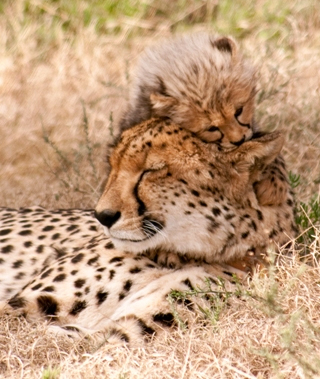
Sibella and her new cubs: photo courtesy of Samara Private Game Reserve, Marnus Ochse
Back to the present day, there is a cheetah baby-boom happening in Samara. Word from the reserve is exciting, two more females known to inhabit the area have given birth to cubs. Birthing during the winter months is no easy feat, a testament to the strength of the resident cats. Cheetahs are thriving in Samara, and with the lack of competition from other predators (lions and hyenas do not inhabit the area), their chance for survival is strong. While lack of genetic diversity is a serious issue in wild cheetah populations, Samara partners with the Endangered Wildlife Trust in swopping cheetahs with other reserves to ensure the gene pool stays as strong as possible. The carrying capacity of the reserve will remain stable and in the future Samara hopes to link with neighboring parks to create one of South Africa’s largest reserves. After 125 years, the cheetah reigns once again in the Eastern Cape.
A Special Report on the cheetah of Samara from General Manager of the Reserve, Marnus Ochse:
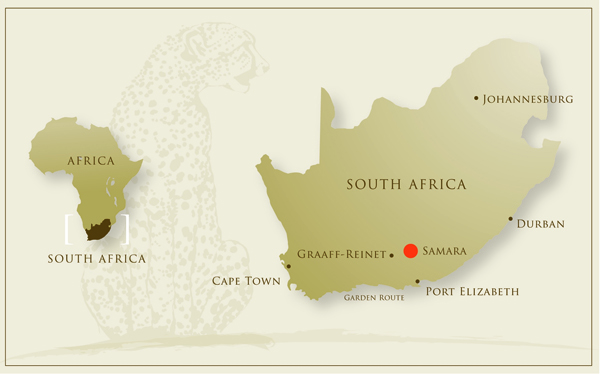
Map of Samara in the Eastern Cape Region of South Africa
It’s been an amazing 2 months with all 3 of our female cheetahs on Samara delivering some new cubs.
First up was Sibella that quietly disappeared into the mountains. After a few days of looking for her, Hayley and Test finally managed to get a signal pointing up in Wolwekloof to the top of the mountain.
To our amazement they found Sibella hidden away in the rocky outcrops with 2 very tiny cubs. The cubs and Sibella managed to survive the cold 2 winter months and we’ve found all 3 of them at the foot of the mountain with Sibella on a kudu kill and 2 healthy looking cubs. The cubs are still being hidden away when Sibella hunts, but they will start moving around more and more with Sibella.
Then in the beginning of July we heard our Master Tracker, Pokkie Benade calling us quite eagerly on the radio. He found a set of 4 different cheetah tracks, 1 adult and 3 cubs (around) 1.5 months old.
Our reserve manager Alan Feldon went out there to have a look to see in which direction they have moved, but with no luck of any visual on that day. With a lot of determination he managed to get a visual of her … with 3 healthy cubs in the southern part of the Reserve.
After releasing Belini in April 2012 we were all eager to see what her movements will be and in which area she will establish herself in. Within the first week we’ve found her on our far eastern boundary with a male. We didn’t think much of it as we knew Belini was still exploring. She started hunting well and managed to bring down big prey using the same technique being used by Sibella which is the ambush technique in the thick riverine bush. Towards the end of July we found Belini on an unusually big kudu kill with which she stayed for about 4 days. She disappeared into the northern part of the reserve and settled down there for about 2 days. Another 2 days passed and our rangers set out to find her again just to find her in exactly the same spot as 2 days ago. At this point we were really worried about her health, but after a close look where she was lying we manage to get visual of 1 cub maybe 1 day old. We immediately moved off to give her some space and to let the cub get a little bit older before we try and get footage. …
It is a real joy to see this species being able to flourish on Samara and we hope that the species’ numbers will just go from strength to strength in Africa.

Sibella and her new cubs: photo courtesy of Samara Private Game Reserve, Marnus Ochse
*except for images of Sibella with cubs, map & volunteers appearing courtesy of Samara Private Game Reserve *

0 Comments